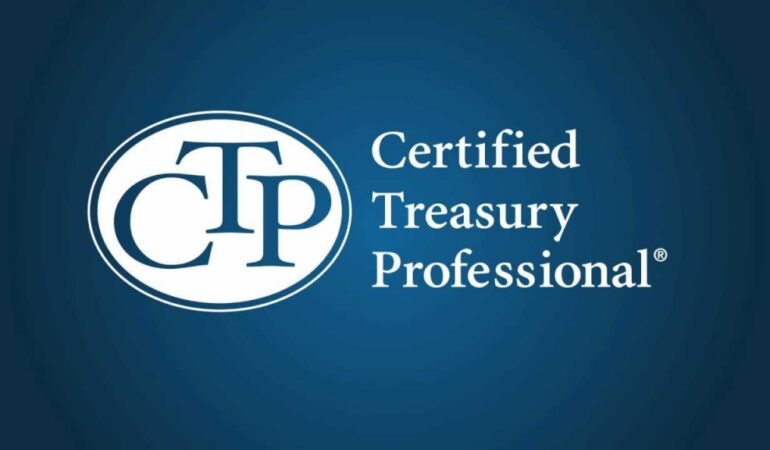
Certified Treasury Professional® (CTP)
Course Description
The Certified Treasury Professional® (CTP) designation serves as a benchmark of competency in the finance profession and is recognized as the leading credential in corporate treasury worldwide. Sponsored by the Association for Financial Professionals® (AFP)
CTP value added:
-
-
- Higher salaries
- Increasing job flexibility and security
- Improving marketability in the job market compared to other applicants
- Boosts relevancy. Stay current in the profession with continuing education requirements.
-
Course content:
Chapter 1: The Role of Treasury Management
-
-
- The Role and Organization of Treasury Management
- Finance and Treasury Organization
- Corporate Governance
-
Chapter 2: Regulatory and Legal Environment
-
-
- General Regulatory Environment
- Primary Regulators and Standard Setters of International Financial Markets
- National/Regional Approaches to Legislation and Regulation
- Tax for Treasury
- Bankruptcy/Insolvency Laws
- Trends in Regulation
-
Chapter 3: Banks and Financial Institutions
-
-
- Financial Institutions: Functions and Services
-
Chapter 4: Payment Systems
-
-
- Payment Overview
- Payment Instruments
- Payment Systems
-
Chapter 5: Money Markets
-
-
- Money Market Participants
- Money Market Instruments
-
Chapter 6: Capital Markets
-
-
- Introduction
- Structure of the Capital Markets
- Debt Market
- Equity Market
-
Chapter 7: Relationship Management and Financial Service Provider Selection
-
-
- Bank Relationship Management
- FSP Selection
- Assessing the Risk of FSPs
-
Chapter 8: Financial Accounting and Reporting
-
-
- Uses of Financial Statements
- Accounting Concepts and Standards
- Financial Statement Reporting
- Accounting for Derivatives, Hedges, and Foreign Exchange (FX) Translation
- Accounting for Governmental and Not-For-Profit (G/NFP) Organizations
-
Chapter 9: Financial Planning and Analysis
-
-
- Time Value of Money
- Capital Budgeting
- Budgeting
- Cost Behavior
- Financial Statement Analysis
-
Chapter 10: Introduction to Working Capital Management
-
-
- The Link Between Cash and Working Capital
- Components of the Capital Cash Conversion Cycle (CCC)
- How Changes in Current Balance Sheet Accounts Impact External Financing
- Strategies for Investing In and Financing Working Capital
- Management of Trade Credit and Accounts Receivable (A/R)
- Management of Inventory
- Management of Accounts Payable (A/P)
- International Working Capital Management Tools
-
Chapter 11: Working Capital Metrics
-
-
- Fundamental Working Capital Metrics
- The Cash Conversion Cycle (CCC)
- Calculations for Trade Credit Decisions
- Accounts Receivable (A/R) Monitoring
-
Chapter 12: Disbursements, Collections, and Concentration
-
-
- Disbursements
- Collections
- Concentration of Funds
-
Chapter 13: Short-Term Investing and Borrowing
-
-
- Managing Short-Term Investments
- Pricing and Yields on Short-Term Investments
- Managing Short-Term Borrowing
- Debt Financing
- Market Information for Investors and Borrowers
- Summary
-
Chapter 14: Cash Flow Forecasting
-
-
- Purpose of Cash Flow Forecasting
- Types of Forecasts
- Forecasting Process
- Forecasting Methods
- Best Practices for Cash Flow Forecasting
-
Chapter 15: Technology in Treasury
-
-
- Information Technology for Treasury
- Treasury Management Systems (TMSs)
- Project Management
- Communications and Technology Developments
-
Chapter 16: Enterprise Risk Management
-
-
- Risk Management
- Categories of Risk
- Techniques Used to Measure Risk
- Managing Insurable Risks
- Disaster Recovery and Business Continuity
-
Chapter 17: Financial Risk Management
-
-
- Types of Financial Risk
- Managing Financial Risk
- Derivative Instruments as Financial Risk Management Tools
- Managing Interest Rate Exposure
- Managing Foreign Exchange (FX) Exposure
- Managing Commodity Price Exposure
- Accounting and Tax Implications of Financial Risk Management
- Hedging Policy Statement
- Summary
-
Chapter 18: Treasury Policies and Procedures
-
-
- Overview of Treasury Policies and Procedures
- Creating a Treasury Policy Document
- Overview of Key Treasury Policies Policy Development Example: Short Term Investment Policy
- Overview of Key Treasury Policies
- Appendix 18.1 – Sample Short-Term Investment Policy
-
Chapter 19: Long-Term Investments
-
-
- Valuation of Capital Market Securities
- Managing Capital Market Investments
-
Chapter 20: The Capital Structure Decision and Management
-
-
- Capital Structure
- Raising and Managing Long-Term Capital
- The Weighted Average Cost of Capital (WACC)
- Lease Financing
- Equity Financing and Management
- Miscellaneous Corporate Finance Topics
-
Training methods:
-
-
- Live online classes
- Digital training
- Inhouse training
-
Course Info
- Start Course: 08/04/2022
- Duration: 18h 30m
- Prerequisites: No
- Skill Level: advanced




